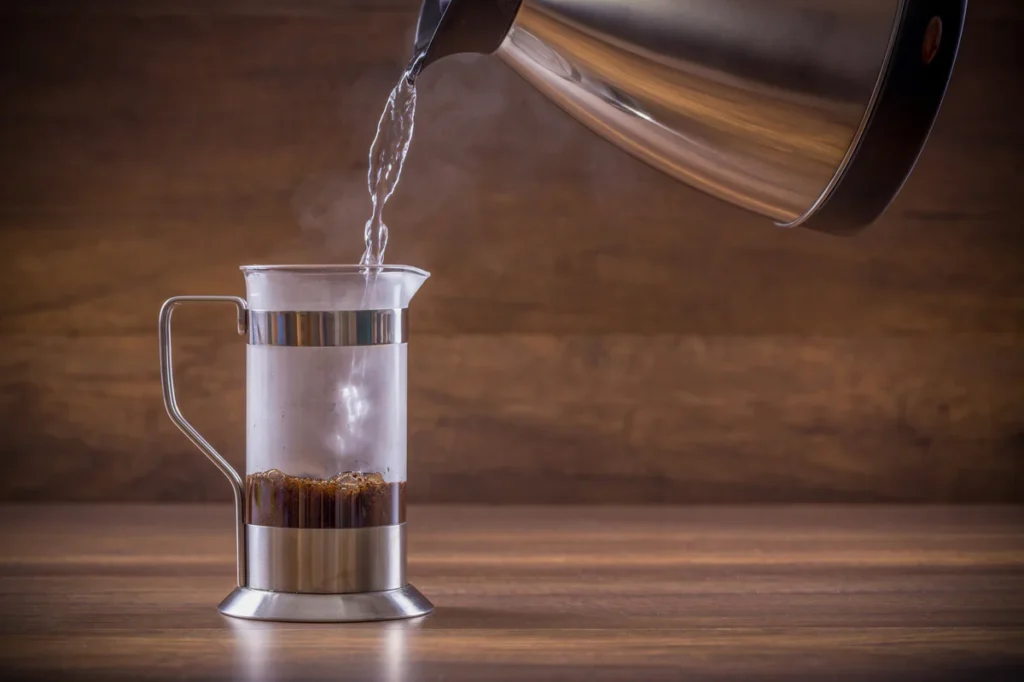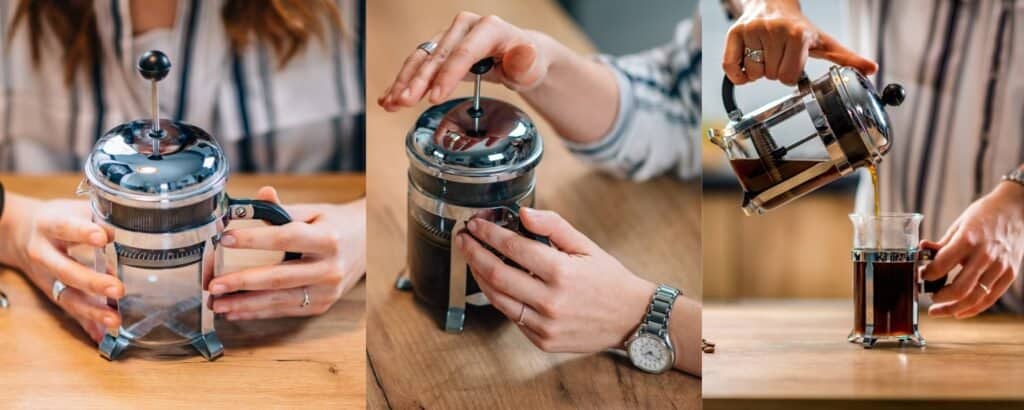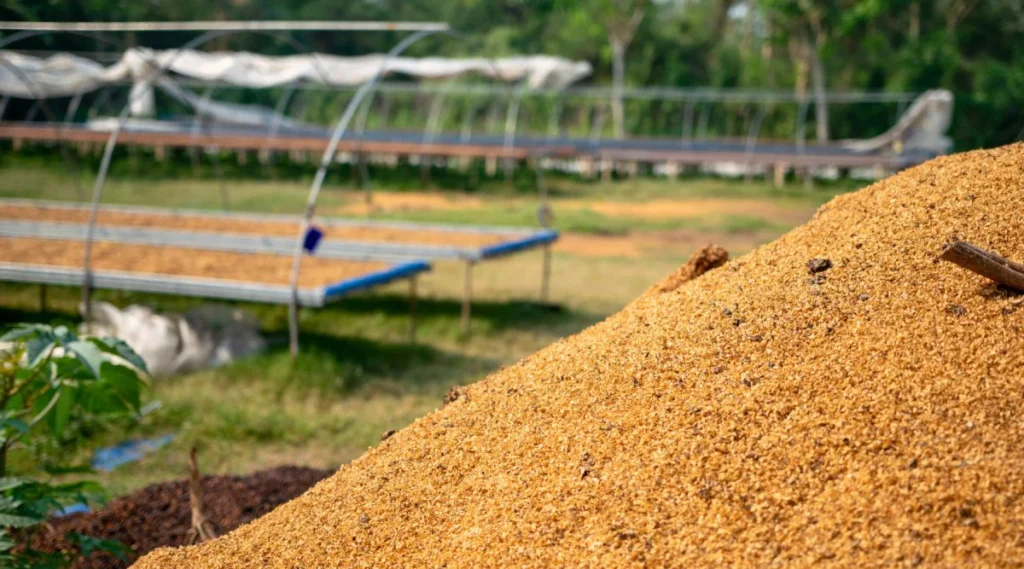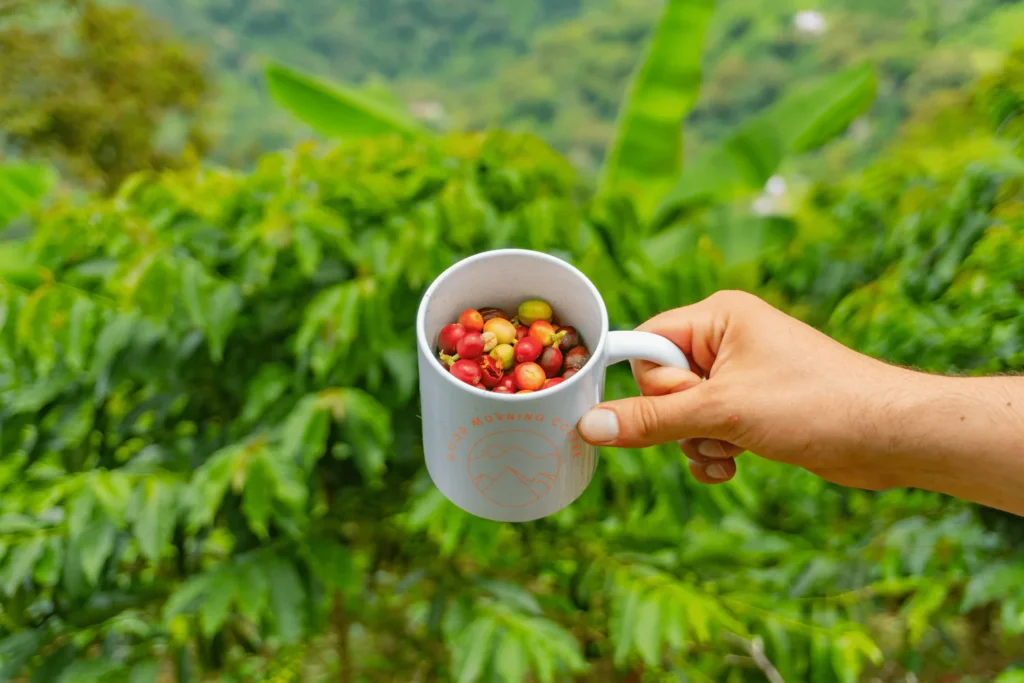When it comes to crafting the perfect cup of French press coffee, the magic lies in the ratio of coffee to water. This seemingly simple factor can dramatically alter the flavor, strength, and overall experience of your brew.
Understanding the ideal coffee to water ratio French press is essential for achieving a balanced and satisfying cup every time. Whether you’re a coffee connoisseur or a casual sipper, getting this ratio right ensures that you unlock the full potential of your beans, delivering a rich, aromatic, and flavorful coffee that hits all the right notes.
Why is this ratio so important? The French press method involves steeping coarse coffee grounds in hot water, allowing the water to extract the coffee’s oils, flavors, and aromas over a few minutes. Too much coffee can make your brew overly strong and bitter, while too little can leave it weak and insipid. By mastering the right coffee to water ratio, you can customize your brew to match your personal preference, achieving a perfect balance between strength and flavor.

Understanding the Basics of French Press Brewing
The French press, also known as a press pot or plunger pot, is a classic method for brewing coffee that has been cherished by coffee enthusiasts for decades. This brewing method involves steeping coarsely ground coffee beans in hot water, then separating the grounds from the brewed coffee by pressing a metal or plastic plunger through a mesh filter. This technique allows the coffee to retain its natural oils and flavors, resulting in a rich and full-bodied cup.
The coffee to water ratio is a critical factor in French press brewing. Using the right amount of coffee and water ensures that you achieve the perfect extraction, which directly impacts the flavor, strength, and overall quality of your coffee. Too much coffee can lead to a bitter and over-extracted brew, while too little can produce a weak and underwhelming cup. By understanding and applying the correct ratio, you can customize your brew to suit your taste preferences and enjoy a consistently great cup of coffee.

Components of French Press
To master French press brewing, it’s essential to understand the components of this simple yet effective device. Each part plays a crucial role in the brewing process:
- Carafe: The main body of the French press, typically made of glass, stainless steel, or plastic. The carafe holds the water and coffee grounds during the brewing process.
- Lid and Plunger: The lid is attached to the plunger, which has a long rod that runs down the center of the carafe. The plunger is used to press the coffee grounds to the bottom of the carafe, separating them from the brewed coffee.
- Filter Screen: Attached to the bottom of the plunger, the filter screen is a fine mesh that allows the brewed coffee to pass through while keeping the grounds at the bottom. This ensures a smooth cup of coffee without the gritty texture.
- Base and Handle: The base provides stability, while the handle allows for easy pouring. These parts are especially important if you’re using a glass carafe, as they help prevent burns and spills.
By understanding these components and how they work together, you can better appreciate the importance of the coffee to water ratio and the overall brewing process.
The Science Behind Coffee to Water Ratios
The coffee to water ratio is the foundation of any great French press brew. This ratio determines how much water you’ll use to extract flavors from a given amount of coffee grounds. The typical ratio recommended for French press coffee is 1:15, meaning one part coffee to fifteen parts water. However, this can be adjusted to match personal preferences for strength and flavor.

How Ratios Affect the Brewing Process
- Flavor: A higher coffee to water ratio (e.g., 1:12) will result in a stronger, more robust flavor, as more coffee is used in proportion to the water. Conversely, a lower ratio (e.g., 1:18) produces a milder brew. Adjusting the ratio allows you to control the intensity of the coffee’s taste.
- Extraction: The ratio directly influences extraction. With more coffee grounds, the water can extract more compounds, leading to a fuller-bodied and richer coffee. If the ratio is too low, the water may over-extract the grounds, resulting in a bitter and unpleasant taste. If too high, the coffee may be under-extracted, leading to a weak and sour brew.
- Caffeine Content: Generally, a higher ratio of coffee to water will increase the caffeine content in your cup, as more coffee grounds release more caffeine during brewing. Adjusting the ratio is a simple way to manage your caffeine intake without compromising on flavor.
Factors Influencing Extraction
Perfecting your French press coffee requires attention to several key factors: grind size, water temperature, and brewing time. Each of these elements plays a crucial role in determining the final taste and quality of your brew.
- Grind Size:
- Ideal for French Press: Coarse grind. The coarse grind ensures a slower extraction process, preventing over-extraction and bitterness. The larger coffee particles are less likely to pass through the filter, resulting in a cleaner cup.
- Adjusting for Taste: If your coffee tastes weak, try a slightly finer grind. If it’s too bitter or gritty, go coarser.
- Water Temperature:
- Optimal Range: 195°F to 205°F (90°C to 96°C). This range allows for proper extraction of flavors without scorching the coffee.
- Adjusting for Taste: If your coffee tastes sour or flat, the water may be too cool. If it’s overly bitter, the water might be too hot. Using a thermometer can help you hit the sweet spot every time.
- Brewing Time:
- Standard Time: 4 minutes. This duration is typically recommended for a balanced extraction.
- Adjusting for Taste: If your coffee is too strong, reduce the brewing time by 30 seconds. If it’s too weak, extend the brewing time by 30 seconds. Small adjustments can make a big difference.
Calculating Your Ideal Coffee to Water Ratio
Finding your perfect coffee to water ratio is a personal journey, influenced by your taste preferences and the specific beans you use. Here’s a simple guide to help you measure and adjust ratios effectively:

- Start with the Standard: Begin with a 1:15 ratio (one part coffee to fifteen parts water). For example, if you’re using 30 grams of coffee, you’ll need 450 grams (or milliliters) of water.
- Measure Precisely: Use a kitchen scale to measure both your coffee and water. Precision ensures consistency in your brews.
- Adjust Gradually:
- For Stronger Coffee: Decrease the water amount slightly (e.g., 1:14 ratio). For 30 grams of coffee, use 420 grams of water.
- For Weaker Coffee: Increase the water amount slightly (e.g., 1:16 ratio). For 30 grams of coffee, use 480 grams of water.
- Consider the Beans: Different beans have different density and flavor profiles. Dark roasts might require a slightly higher ratio (1:16), while lighter roasts can handle a more concentrated ratio (1:14).
- Taste Test: After brewing, taste your coffee. Note its strength, flavor, and balance. Adjust your ratio based on these observations until you find your perfect brew.
Tools and Apps for Precision
Achieving the perfect French press coffee is easier with the right tools and apps to help you measure and convert ratios accurately:

- Digital Kitchen Scale: A must-have for precise measurements of coffee and water. Look for scales with a tare function to zero out the weight of your container.
- Thermometer: Ensures your water is at the optimal temperature for brewing. Instant-read thermometers are convenient and accurate.
- Brew Timer: Helps you track brewing time. Many coffee scales come with built-in timers, or you can use a simple kitchen timer.
- Coffee-to-Water Ratio Calculators: Numerous apps and websites offer ratio calculators. Simply input the amount of coffee or water you’re using, and they’ll compute the corresponding amount needed. Some popular options include:
- Coffee Ratio: A straightforward app for calculating coffee-to-water ratios.
- Acaia Coffee: Offers both a scale and app for precise brewing measurements and tracking.
- Brew Timer by Perfect Coffee: Combines a timer with ratio calculations to help you brew consistently great coffee.
Practical Guide to Brewing with French Press
Brewing with a French press is a straightforward process, but attention to detail can make all the difference in achieving that perfect cup. Here’s a step-by-step guide to help you brew French press coffee using the ideal coffee-to-water ratio.

Measure Your Coffee and Water: Use a kitchen scale to measure out your coffee grounds and water. For a standard 1:15 ratio, you’ll need 30 grams of coffee for 450 grams (milliliters) of water.
Grind the Coffee: Use a burr grinder to grind your coffee beans to a coarse consistency. The grounds should resemble sea salt in texture.
Boil and Cool the Water: Boil your water and then let it cool slightly to reach the optimal brewing temperature of 195°F to 205°F (90°C to 96°C).
Preheat the French Press: Pour a small amount of hot water into the French press to preheat it. Swirl it around and then discard the water.
Add Coffee Grounds: Add the measured coffee grounds to the preheated French press, ensuring an even distribution across the bottom.
Pour in Water: Start a timer and pour half of the hot water over the coffee grounds, making sure all grounds are saturated. Let it bloom for about 30 seconds.
Stir and Add Remaining Water: After the bloom, stir the coffee grounds gently, then add the remaining water.
Place the Lid: Place the lid on the French press with the plunger pulled all the way up. This helps retain heat during brewing.
Brew Time: Allow the coffee to steep for 4 minutes. Adjust brewing time slightly based on your taste preferences.
Press the Plunger: After 4 minutes, slowly press the plunger down. Apply steady pressure to avoid agitation and over-extraction.
Serve and Enjoy: Pour your freshly brewed coffee into a cup and enjoy. To avoid bitterness, do not let the coffee sit in the French press for too long after pressing.
Troubleshooting Common Issues
Even with the best intentions, things can sometimes go awry in the brewing process. Here are some tips to troubleshoot common French press coffee issues:
- Under-Extraction:
- Symptoms: Sour or weak flavor.
- Solutions:
- Grind Size: Make sure your grind is not too coarse.
- Water Temperature: Ensure your water is within the optimal range (195°F to 205°F).
- Brewing Time: Extend the steeping time slightly.
- Over-Extraction:
- Symptoms: Bitter or harsh flavor.
- Solutions:
- Grind Size: Ensure your grind is not too fine.
- Water Temperature: Use water that is not too hot.
- Brewing Time: Reduce the steeping time by 30 seconds.
- Sediment in Coffee:
- Symptoms: Gritty texture in the cup.
- Solutions:
- Grind Size: Use a coarser grind.
- Plunge Technique: Press the plunger slowly and evenly to prevent grounds from passing through the filter.
- Weak Coffee:
- Symptoms: Bland or watery taste.
- Solutions:
- Coffee to Water Ratio: Increase the amount of coffee relative to water.
- Grind Size: Ensure your grind is not too coarse, which can result in under-extraction.
- Too Strong Coffee:
- Symptoms: Overly intense or overpowering flavor.
- Solutions:
- Coffee to Water Ratio: Decrease the amount of coffee relative to water.
- Brewing Time: Reduce the steeping time slightly.
Enhancing Your French Press Coffee Experience
Once you’ve mastered the basics of brewing French press coffee, there are several techniques you can use to elevate your coffee experience even further. These methods can enhance the flavor, aroma, and overall enjoyment of your brew.

- Pre-Infusion (Blooming):
- What It Is: Pre-infusion involves pouring a small amount of hot water over the coffee grounds and letting it sit for about 30 seconds before adding the rest of the water.
- Why It Works: This process allows the coffee to release trapped gases, leading to better extraction and a more flavorful cup.
- How to Do It: Add enough water to just cover the grounds, wait 30 seconds, then continue with the remaining water as usual.
- Using Specialty Beans:
- What It Is: Specialty beans are high-quality coffee beans sourced from specific regions and roasted to highlight their unique flavor profiles.
- Why It Works: These beans often have complex flavors and aromas that can significantly enhance your coffee experience.
- How to Do It: Experiment with beans from different regions, such as Ethiopia, Colombia, or Kenya, to discover new flavors and aromas.
- Adjusting Grind Size:
- What It Is: Fine-tuning the grind size can help you achieve the perfect extraction.
- Why It Works: A slightly finer or coarser grind can make a big difference in the flavor balance.
- How to Do It: If your coffee tastes off, try adjusting the grind size slightly and observe the changes in flavor.
- Water Quality:
- What It Is: The quality of the water you use can impact the taste of your coffee.
- Why It Works: Impurities or high mineral content can alter the flavor profile.
- How to Do It: Use filtered water to ensure a clean and pure taste.
- Brewing Temperature:
- What It Is: Slightly tweaking the water temperature can enhance flavor extraction.
- Why It Works: Different beans respond differently to various temperatures.
- How to Do It: Experiment with water temperatures within the optimal range (195°F to 205°F) to find what works best for your beans.
Recipes and Variations
Once you’ve perfected your French press coffee, you can explore different recipes and variations to keep things exciting. Here are a few to try:

- French Press Iced Coffee:
- Ingredients: 60 grams coffee, 900 grams water, ice.
- Instructions: Brew coffee as usual, but use a higher coffee-to-water ratio (1:15). Once brewed, pour the hot coffee over a glass full of ice. Stir and enjoy a refreshing iced coffee.
- French Press Latte:
- Ingredients: 30 grams coffee, 450 grams water, milk or milk alternative.
- Instructions: Brew coffee as usual. While the coffee is brewing, heat your milk until it’s steaming (but not boiling). Froth the milk using a frother or whisk. Pour the brewed coffee into a cup and top with frothed milk.
- Vanilla French Press Coffee:
- Ingredients: 30 grams coffee, 450 grams water, 1 tsp vanilla extract, sugar to taste.
- Instructions: Add coffee grounds and vanilla extract to the French press. Brew as usual. Sweeten with sugar if desired.
- Cinnamon French Press Coffee:
- Ingredients: 30 grams coffee, 450 grams water, 1 tsp ground cinnamon.
- Instructions: Add coffee grounds and ground cinnamon to the French press. Brew as usual. Enjoy the warm, spicy notes of cinnamon in your coffee.
- Chocolate French Press Coffee:
- Ingredients: 30 grams coffee, 450 grams water, 1 tbsp cocoa powder, sugar to taste.
- Instructions: Add coffee grounds and cocoa powder to the French press. Brew as usual. Sweeten with sugar if desired for a mocha-like experience.
Sustainability and Coffee Choices
When it comes to coffee choices, opting for sustainable brands isn’t just about being trendy; it’s about making a positive impact on both quality and the planet. Sustainable coffee brands prioritize ethical sourcing practices, supporting farmers with fair wages, and using environmentally friendly farming methods.
This commitment often translates into better-tasting coffee because sustainable practices often yield higher-quality beans. Moreover, by choosing these brands, you’re supporting ecosystems and biodiversity crucial for coffee cultivation, which is often threatened by conventional farming methods.
So, next time you sip your morning brew, consider reaching for a sustainable option—it’s a small choice that makes a big difference in flavor and environmental stewardship.
Disclosure: Our blog contains affiliate links to products. We may receive a commission for purchases made through these links. However, this does not impact our reviews and comparisons. We try our best to keep things fair and balanced, in order to help you make the best choice for you.




